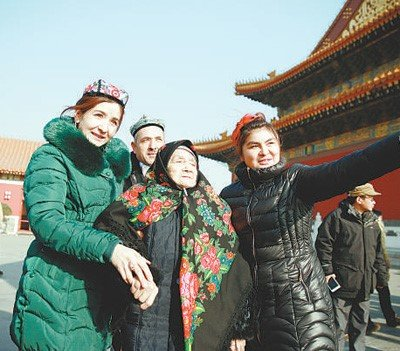By Tom McGregor, CCTV.com Panview commentator and editor
Editor's Note: CCTV.com Panview presents 'China Cares' — series of special coverage on China's rural reforms, charities and comprehensive efforts to help those in poverty unlock their potential for success.
The Xinjiang Uygur Autonomous Region stands in the far northwestern part of China, which is largely surrounded by deserts and mountain landscapes. There’s a prevailing sense of isolation as nomads travel through the region.
But where many people see challenges others, including the Central Government and Chinese businesses, view it as the land of opportunity, since it’s rich in natural resources and the gateway for China, Middle East and Central Asia.
Xinjiang might be sparsely populated, but Beijing has made tremendous strides to develop northwestern China and the results appear remarkable.
The regional GDP (gross domestic product) has enjoyed an average annual increase - 9.3 percent from 2012 to 2016; RMB752.9bn (US$114bn) - 2012, to RMB 965bn (US$140bn) - 2016.
Investments and projects pour in
Beijing has called for increasing investments and government support to maintain Xinjiang's rapid development. Shohrat Zakir, chairman of the regional government, is quoted by WomenofChina Website as saying, "Xinjiang uses 70 percent of its annual fiscal budget to improve lives."

(Great granddaughter of Kurban Tulum (fourth left), a Uygur patriot, accompanies a 106-year-old senior Uyghur (third left) to visit the Tian'anmen Rostrum in Beijing, January 19, 2016. Photo from People's Daily)
The regional government has approved over 5,000 projects to promote development with a total investment - RMB47.5bn in 2013-2016.
The amount of registered poor people in Xinjiang had dropped from 2.61 million in 2013 to 1.22 million in 2016 with another 590,000 anticipated to be lifted out of poverty by the end of 2017.
Local governments have offered generous benefits, such as better rural housing, settlements for herders and more affordable housing units. And in southern Xinjiang, residents receive full coverage on primary and middle schools education, vocational training and free health check-ups for all ethnic groups.
'Core Zone' Silk Road Economic Belt
Chinese President Xi Jinping introduced the Silk Road Economic Belt and 21st Century Maritime Silk Road to build major infrastructure projects to boost cross-border trade in Asia, Middle East, Eur-Asia and Africa.
He delivered an announcement on the Belt & Road Initiative at Astana, Kazakhstan in 2013.
Beijing has kept close bilateral ties with countries in Central and Western Asia, which remain under-developed, but rich in natural resources, particularly energy (oil, gas and coal), as well as minerals (gold, silver and rare earth materials).
Xinjiang, which borders eight countries, including Pakistan, Mongolia, Kazakhstan and India, is the 'front gate' for China to open up to Central and Western Asia and a crucial pivot place for the B&R.
Renewed efforts on CPEC
A flagship project for B&R is the China-Pakistan Economic Corridor (CPEC) that would connect Chinese exporters who hope to deliver goods through Pakistan’s deep water Gwadar Port on the Arabian Sea.
An intricate web of infrastructure projects will come at an expected total cost - US$62bn. CPEC will play as a regional hub to energy, free trade and manufacturing zones.
More highways, railways and airports are expected to be built here that will serve as the modern-day version of the ancient Silk Road when about 1,000 years ago, a caravan of Arabic traders traveled through the region to resell goods purchased from China’s market stalls.
The Guardian newspaper even printed a story on the tiny Chinese border village Tashkurgan and how it has experienced an overall positive impact from the B&R.
Energy hub for the rest of China
Tashkurgan lies at the end of the recently completed 1,300-km. Karakoram Highway that goes through the nation’s western mountains, which includes the 4700-m high Khunjerab Pass. It’s one of the highest altitude long-distance highways open to the public.
Beijing has plenty of other reasons to support development in Xinjiang and its isolated villages, since it’s believed the region holds the largest oil and gas reserves in the country.
According to a 2014 report published by the US Energy Information Administration US EIA, 40 percent of China’s natural gas reserves have been spotted in Xinjiang.

(Xinjiang Uygur Autonomous Region in northwest China has transformed into the premier national energy hub, which holds the country’s largest oil, gas and coal reserves. Photo from Internet)
The State Council, China's Cabinet, has authorized state-owned energy giants - CNOOC, PetroChina and Sinopec - to ramp up exploration and production in the region and to sign more joint venture deals with foreign-based firms.
US-based General Electric (GE) is constructing nine small-scale LNG (liquefied natural gas) plants that will have daily production capacity 50,000 cubic meters by the end of 2018.
There's tourism here too
The Xinjiang Uighur Autonomous Region is not only well known for its natural resources, but it's also recognized as a trendy hot-spot for adventure tourism and Islamic pilgrimages. The desert landscapes and rugged mountains are not for the faint-hearted.
Uygurs are an ethnic minority group who celebrate Islam with Chinese characteristics, hence they have built beautiful mosques in the region and developed tourist sites and festivals for Muslims to participate in.
Xinhua reports that during the Corban Festival (Eid al-Adha), an Islamic holy day, that encourages the faithful to make family sacrifices of livestock and share the food with loved ones, had witnessed over six million in-bound tourists coming to the region on Sept. 1-5, 2017.
A thriving tourism industry, serious reductions on poverty levels and rapid regional GDP growth show that Beijing really does care about Xinjiang, as well as its people and future prospects.
(The opinions expressed here do not necessarily reflect the opinions of Panview or CCTV.com. )

Panview offers a new window of understanding the world as well as China through the views, opinions, and analysis of experts. We also welcome outside submissions, so feel free to send in your own editorials to "globalopinion@vip.cntv.cn" for consideration.
















